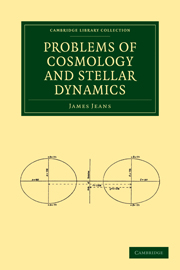Book contents
- Frontmatter
- Preface
- Contents
- I Introductory Chapter
- II General Dynamical Principles
- III Ellipsoidal Configurations of Equilibrium
- IV The Gravitational Potential of a Distorted Ellipsoid
- V Pear-shaped Configurations of Equilibrium
- VI Motion when there are no Stable Configurations of Equilibrium
- VII The Motion of Compressible and Non-homogeneous Masses
- VIII The Evolution of Gaseous Masses
- IX The Evolution of Rotating Nebulae
- X The Evolution of Star-Clusters
- XI The Evolution of Binary and Multiple Stars
- XII The Origin and Evolution of the Solar System
- Index
- Plate section
VI - Motion when there are no Stable Configurations of Equilibrium
Published online by Cambridge University Press: 05 October 2010
- Frontmatter
- Preface
- Contents
- I Introductory Chapter
- II General Dynamical Principles
- III Ellipsoidal Configurations of Equilibrium
- IV The Gravitational Potential of a Distorted Ellipsoid
- V Pear-shaped Configurations of Equilibrium
- VI Motion when there are no Stable Configurations of Equilibrium
- VII The Motion of Compressible and Non-homogeneous Masses
- VIII The Evolution of Gaseous Masses
- IX The Evolution of Rotating Nebulae
- X The Evolution of Star-Clusters
- XI The Evolution of Binary and Multiple Stars
- XII The Origin and Evolution of the Solar System
- Index
- Plate section
Summary
The result obtained in the last chapter for the rotational problem combined with those previously obtained in Chapter III for the tidal and double-star problems, has now established that
In all the three problems under consideration there are no figures of stable equilibrium except ellipsoids and spheroids.
In each of these problems the succession of states has been determined by the continuous variation of a parameter–the angular momentum in the rotational and double-star problems, and the distance R in the tidal problem. And in each case it is quite possible for this parameter to vary to beyond the limits within which stable configurations are possible. We must accordingly try to obtain what information we can as to the changes to be expected after this-limit is passed.
Poincaré, writing with special reference to the rotational problem, remarks that if the pear-shaped figure proved to be unstable, “la masse fluide devrait se dissoudre par un cataclysme subit.” The pear-shaped figure has now been proved to be unstable, and we must examine the nature of the cataclysm. The situation is similar in the two other problems; when the two masses concerned in either approach one another to within less than a certain distance no configurations of stable equilibrium are possible, and a cataclysm occurs.
- Type
- Chapter
- Information
- Problems of Cosmology and Stellar Dynamics , pp. 117 - 138Publisher: Cambridge University PressPrint publication year: 2009First published in: 1919

